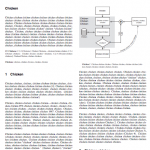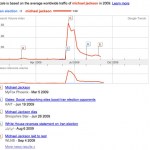
Instead of me answering that, I wondered instead how other people have argued about the question. To be more specific, since I am interested in the role of scientific practice for defining the land, I wondered how people argued about whether or not science was better for agriculture. I wrote a book about it. It's called Notes from the Ground: Science, Soil, and Society in the American Countryside. I commented here a few months ago that the book was finally on its way. Although Amazon sales do not begin until October 20th (here is their link), the publisher has it officially listed for…
Believe it or not, this is the second post at the World's Fair which just has the word "chicken" three times in the title. Anyway, this went viral a few years ago, but for some reason I find it really really funny. Plus, it's on my mind because it relates a little to an event I'm involved in coming up, which is all about presentation and speaking opportunities.
Here's the paper (front page shown and link to pdf here)
And here is the video:
How he handles the question at the end is particularly inspired.
... it's kind of funny.
Properties I Learned In Math Class On Brownian Motion (BM), with Explanations.
BY SCOTT LOWENSTEIN
- - - -
1. BMs come in two forms: "standard" and "multidimensional"
2. Law of large numbers: expected distance traveled during a BM = 0
3. Scaling: a scaled up BM is still a standard BM, it'll just take longer to get where you're going
4. Strong Markov property: the flow of BMs in the future are unaffected by BMs in the present after a stopping point has been reached
5. Law of iterated logs: duh
- - -
(From the ever entertaining McSweeneys.net)
Not specifically about science literacy, but more about just what inhabits a person's brain space at a given moment, and how that can lead to a sad degree of ignorance in world affairs.
I was mulling over this, when watching a television program called the "Long Way Down" about two motorcyclists (Ewan MacGregor and Charley Boorman) touring from the northern tip of Scotland to the southern tip of South Africa. It's a great show, where a lot of the focus of the programming was on their experiences in the African countries they rode through. There was one segment in particular that was…
Dear Luke,
I just saw a photo of your glass sculpture of HIV.
I can't stop looking at it. Knowing that millions of those guys are in me, and will be a part of me for the rest of my life. Your sculpture, even as a photo, has made HIV much more real for me than any photo or illustration I've ever seen. It's a very odd feeling seeing my enemy, and the eventual likely cause of my death, and finding it so beautiful.
Thankyou.
The above is letter inspired by some glass sculptures delicately created by Luke Jerram. They are spectacular, and I'm pretty sure you don't need to be a science junkie to…
A review of Cocktail: A Play about the Life and HIV Drug Development Work of Dr. Krisana Kraisintu by Vince LiCata and Ping Chong
Truth be told, I don't read plays very often, if at all. In fact, I'm ashamed to admit that I think the last one I read was back in high school long ago, and if I remember correctly had something to do with vampires - ironic in that vampires at the time were not so popular. But this play was about something I am interested in - medicine and social responsibility - and it was referred to by a friend, who also happened to be one of the authors.
Coincidentally,…
This is up (I'm sure) everywhere, but I can't resist also showing it off, especially since I've played around with the science song genre myself.
And you can buy the CD/DVD set for yourself (or your kids) at Amazon.
First, take a quick peek at this Gapminder.org video for a general sense of the problem:
Now, this video is from May 2009, after the first few weeks of the initial outbreak, and it also has a focus on media representation, but with the recent worry over potential variants of the H1N1 virus rearing in the next little while, a similar issue has come up.
This time concerning the number of dollars spent on mitigating a potential health crisis.
More specifically: How, if in the face of serious health concerns, can developed countries suddenly find the will to fund major health initiatives (and…
It's that time of year again, where I need to make a goofy video to promote a student conference. Last year, I did one on Things to Avoid When Speaking Publicly; this year I had to make sure Chewbacca was figured prominently.
Do spread the word about TEDxTerrytalks 2009 (especially if you're from UBC), and hope you enjoy the video (you can spread that too).
- - -
As a side note, I'm sure I forgot some notable characters that could've also given a stellar talk on something or other. Pass on your extra ideas in the comment section - maybe I'll make a sequel.
Just saw the tally on the blog, and it seems that the last time I wrote here was well over two months ago. Well, most of that has to do with a trip to Ibadan, Nigeria, and an extended bout with jet lag, but I'm back into the blogging mood again.
To start with, I thought I'd have a hand at a Harper's Index type post, detailing some of the things I saw and discovered at my trip. Also take a gander at some of photos I took below.
- - -
Some points to consider.
Topic of workshop delivered by author of post (and his colleague Joanne Fox) - Molecular Biology and Bioinformatics;
Number of…
I had the chance to interview Rebecca Solnit for The Believer. It's on shelves now, in their September issue. They've also put the full text of it on-line at their website. (Here it is.)
To quote the interview's intro, Solnit is the author of twelve books. She is a journalist, essayist, environmentalist, historian, and art critic; she is a contributing editor to Harper's, a columnist for Orion, and a regular contributor to Tomdispatch.com and The Nation; she's also written for, among other publications, the L.A. Times, the San Francisco Chronicle, and the London Review of Books.
She talks…
A William Blake quatrain, from "Auguries of Innocence":
To see a world in a grain of sand,
And a heaven in a wild flower,
Hold infinity in the palm of your hand,
And eternity in an hour.
In a short film hosted at the Radiolab "Pipes" site, William Hoffman captures something like infinity in the palm of his hand:
If this embedded version doesn't work on your browser, use this link and watch it as full screen.
Pt. 1 | Pt. 2 | Pt. 3
---
Part 3 with Julie Sze, discussing her book Noxious New York, follows below. All entries in the author-meets-blogger series can be found here.
WF: What place did science play in the EJ issues of the communities you've studied? We've talked about tensions between expertise, technical knowledge, and lived community experience in other conversations. It's a vast subject, in fact, and I shouldn't cast this question so tidily. But for Noxious New York, where did scientific practices fit?
JS: Science played a large part in the story I told in New York City, a story…
Part 1 | Pt. 2 (below) | Pt. 3
---
Part 2 with Julie Sze, discussing her book Noxious New York, follows below. All entries in the author-meets-blogger series can be found here.
WF: Let's do this: I know we already brought up environmental justice before, but could you define it in your terms for the readers? In your use and experience, does it differ from environmental racism, does it differ from, say, an anti-toxics activism that some link to Love Canal and Lois Gibbs?
JS: That is a huge question in the book. I define environmental justice as the social movement that emerged in response…
Part 1 (below) | Pt. 2 | Pt. 3
---
The World's Fair is pleased to offer the following discussion about Noxious New York: The Racial Politics of Urban Health and Environmental Justice (MIT Press, 2007), with its author Julie Sze. Sze is an associate professor of American Studies at the University of California at Davis, an environmental justice scholar, and the founding director of the Environmental Justice Project at the John Muir Institute for the Environment.
Noxious New York "analyzes the culture, politics, and history of environmental justice activism in New York City within the…
Old school The Onion re-posted below, from 2002:
"Guns Are Only Deadly If Used For Their Intended Purpose"
By Ted Farner
President, Brothers In Arms U.S.A.
June 12, 2002 | Issue 38â¢22
"As the president of Brothers In Arms U.S.A., the nation's third-largest gun-rights organization, I've heard all the arguments made by the anti-gun propagandists. And of the many misguided aspects of their anti-gun rhetoric, the most off-base is this bizarre notion that guns are inherently deadly. Nothing could be further from the truth. The reality is, guns are only deadly when used for their intended purpose…
Seed/Scienceblog alum Katherine Sharpe (she of austere head office fame), recently conducted a fascinating experiment in deprivation. There's Lent, of course, the standard bearer of voluntary deprivation. And there are those who give up caffeine, or television, or the internet, or long lists, or sarcasm for some time. But this is the first I've seen of someone trying to live in our culture, our 21st century hyper-consumer, radically plasticized culture, without plastics. But Katherine tried it. Plus, she began it with a nod to Chris Jordan's compelling art on our plasticized world (about…
On we go, with the third entry in "Days at the Museum" over at McSweeney's, titled "Mind the Gap." It ran yesterday. It's theme? Beyond relating to a subway conversation, I'd summarize it as being about the gap between what I expected here and what I'm finding.
This is part three of "Days at the Museum." Part I was noted here; it was about macaroni, and France, and tourists. Part 2 was noted here; it was about elevators, more or less. Have a time with them.
Not the best title for a post, and by best, I mean most accurate. If you'd like to get to the bottom of it, though, try this new dispatch over at McSweeney's: "The Elevator to Room 1028." It has elevators. It has intrigue. It has secrecy. It has stacks of books. And it has elevators.
This is part two of "Days at the Museum." Part I was noted here. It had a better picture.
Tim LeCain, a professor at Montana State (in Bozeman) and a talented scholar in environmental history and the history of technology ("envirotech"), has just published Mass Destruction: The Men and Giant Mines that Wired America and Scarred the Planet. Although I've not read it yet, I'm familiar with LeCain's work in general (having read prior work that is now part of the book). He's a solid scholar and a notable writer; this is important work.
I copy here from the Rutgers Press description of the book:
The place: The steep mountains outside Salt Lake City. The time: The first decade of the…



